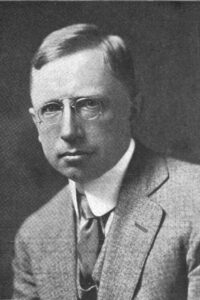
The Banker and the Bear, The Story of a ”Corner” in Lard
For more than forty years Bagsbury and Company was old John Bagsbury himself; merely another expression of his stiff, cautious personality. Like him it had been old from infancy; you could as easily imagine that he had once been something of a dandy, had worn a stiff collar and a well-brushed hat, as that its dusty black-walnut furniture had ever smelled of varnish. And, conversely, though he had a family, a religion to whose requirements he was punctiliously attentive, and a really fine library, the bank represented about all there was of old John Bagsbury.
Besides a son, John, he had a daughter, born several years earlier, whom they christened Martha. She grew into a capricious, pretty girl, whom her father did not try to understand, particularly as he thought she never could be of the smallest importance to Bagsbury and Company. When, before she was twenty, in utter disregard of her father’s forcibly expressed objection, she married Victor Haselridge, she dropped forever out of the old man’s life.
The boy, John, was too young to understand when this happened, and as his mother died soon after, he grew almost to forget that he had ever had a sister. He was very different: serious and, on the surface at least, placid. He had the old man’s lumpy head and his thin-lidded eyes, though his mouth was, like his mother’s, generous. His father had high hopes that he might, in years, grow to be worthy of Bagsbury and Company’s Savings Bank. That was the boy’s hope, too; when he was fifteen he asked to be taken from school and put to work, and his father, with ill-concealed delight, consented. Through the next five years, the old man’s hopes ran higher than ever, for John showed that he knew how to work, and slowly—the tenure of office was long at Bagsbury’s—he climbed the first few rounds of the ladder.
But trouble was brewing all the while, though the father was too blind to see. It began the day when the lad first set foot in a bank other than his father’s. The brightness, the bustle, and the alert air that characterized everyone about it brought home to him a sharp, disappointing surprise.
Read or download Book
Henry Kitchell Webster
Henry Kitchell Webster (September 7, 1875 – December 8, 1932) was an American who was one of the most popular serial writers in the country during the early twentieth century. He wrote novels and short stories on themes ranging from mystery to family drama to science fiction and pioneered techniques for making books best sellers.
Personal life
Henry Kitchell Webster was the oldest child of Chicago industrialist Towner K. Webster and Emma Josephine Kitchell. He graduated from Hamilton College in 1897 and taught rhetoric at Union College the following year. Otherwise, he lived most of his life in Evanston, Illinois. He married Mary Ward Orth, on September 7, 1901. In 1910, after his earliest novels achieved success, he and Mary traveled around the world. The couple had three sons; Henry Kitchell Jr. (1905), Stokely (1912) who became a well-known impressionist painter, and Roderick (1915), who was Chairman of Adler Planetarium and benefactor of its Webster Institute. In 1922, the family spent a year living and traveling in Europe. They rented an apartment on the Rive Gauche in Paris, during which time Stokely studied painting with a family friend, the American artist Lawton S. Parker. Webster was friends with many actors and opera stars, including Ethel Barrymore who starred in his 1912 Broadway play June Madness.
In 1930, Webster wrote a memoir of his father which was published by his brother-in-law Walter A. Strong. In the summer of 1932, Webster was diagnosed with cancer. He died the following December at the age of 57. At the time of his death, Webster had partially completed a mystery, The Alleged Great-Aunt. His wife gave the manuscript to his friends Janet Ayer Fairbank and Margaret Ayer Barnes, who completed and published it in 1935.
Popularity
He first achieved moderate recognition in 1899 when he co-wrote The Short Line War with fellow Illinois author Samuel Merwin, with whom he later collaborated to write one of his more famous works, Calumet “K” (1901). Calumet “K”, which The Chicago Daily Tribune called “a vivifying romance of business,” has maintained a modest level of popularity due to its status as Ayn Rand’s favorite novel, a source of inspiration for her Objectivist philosophy. Webster’s novels The Real Adventure (1916) and An American Family: A Novel of Today (1918) both received critical praise upon release, and the former novel was made into a silent film in 1922. By the time of his death, Webster had become one of the most popular authors of magazine serials in America, and “was largely instrumental in the great literary revolution of the generation, making best books ‘best sellers'”.






